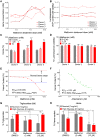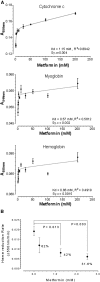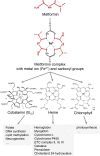Metformin Affects Heme Function as a Possible Mechanism of Action
- PMID: 30554148
- PMCID: PMC6385989
- DOI: 10.1534/g3.118.200803
Metformin Affects Heme Function as a Possible Mechanism of Action
Abstract
Metformin elicits pleiotropic effects that are beneficial for treating diabetes, as well as particular cancers and aging. In spite of its importance, a convincing and unifying mechanism to explain how metformin operates is lacking. Here we describe investigations into the mechanism of metformin action through heme and hemoprotein(s). Metformin suppresses heme production by 50% in yeast, and this suppression requires mitochondria function, which is necessary for heme synthesis. At high concentrations comparable to those in the clinic, metformin also suppresses heme production in human erythrocytes, erythropoietic cells and hepatocytes by 30-50%; the heme-targeting drug artemisinin operates at a greater potency. Significantly, metformin prevents oxidation of heme in three protein scaffolds, cytochrome c, myoglobin and hemoglobin, with Kd values < 3 mM suggesting a dual oxidation and reduction role in the regulation of heme redox transition. Since heme- and porphyrin-like groups operate in diverse enzymes that control important metabolic processes, we suggest that metformin acts, at least in part, through stabilizing appropriate redox states in heme and other porphyrin-containing groups to control cellular metabolism.
Keywords: diabetes; heme; hemoprotein; mechanism of action; metformin; porphyrin; redox.
Copyright © 2019 Li et al.
Figures




Similar articles
-
Role of AMP-activated protein kinase in mechanism of metformin action.J Clin Invest. 2001 Oct;108(8):1167-74. doi: 10.1172/JCI13505. J Clin Invest. 2001. PMID: 11602624 Free PMC article.
-
Metabolic switching in the hypoglycemic and antitumor effects of metformin on high glucose induced HepG2 cells.J Pharm Biomed Anal. 2018 Jul 15;156:153-162. doi: 10.1016/j.jpba.2018.04.029. Epub 2018 Apr 21. J Pharm Biomed Anal. 2018. PMID: 29705631
-
Metformin inhibits heme oxygenase-1 expression in cancer cells through inactivation of Raf-ERK-Nrf2 signaling and AMPK-independent pathways.Toxicol Appl Pharmacol. 2013 Sep 1;271(2):229-38. doi: 10.1016/j.taap.2013.05.010. Epub 2013 May 21. Toxicol Appl Pharmacol. 2013. PMID: 23707609
-
A reappraisal on metformin.Regul Toxicol Pharmacol. 2018 Feb;92:324-332. doi: 10.1016/j.yrtph.2017.12.023. Epub 2017 Dec 30. Regul Toxicol Pharmacol. 2018. PMID: 29291990 Review.
-
[Molecular action of insulin-sensitizing agents].Endokrynol Pol. 2005 May-Jun;56(3):308-13. Endokrynol Pol. 2005. PMID: 16350724 Review. Polish.
Cited by
-
Gut microbiome encoded purine and amino acid pathways present prospective biomarkers for predicting metformin therapy efficacy in newly diagnosed T2D patients.Gut Microbes. 2024 Jan-Dec;16(1):2361491. doi: 10.1080/19490976.2024.2361491. Epub 2024 Jun 13. Gut Microbes. 2024. PMID: 38868903 Free PMC article.
-
Metabolic Action of Metformin.Pharmaceuticals (Basel). 2022 Jun 30;15(7):810. doi: 10.3390/ph15070810. Pharmaceuticals (Basel). 2022. PMID: 35890109 Free PMC article. Review.
-
Unravelling genetic components of longevity.Nat Aging. 2022 Jan;2(1):5-6. doi: 10.1038/s43587-021-00162-z. Nat Aging. 2022. PMID: 37118361 Free PMC article.
-
Commentary: Lactate-Induced Glucose Output Is Unchanged by Metformin at a Therapeutic Concentration-A Mass Spectrometry Imaging Study of the Perfused Rat Liver.Front Pharmacol. 2019 Feb 19;10:90. doi: 10.3389/fphar.2019.00090. eCollection 2019. Front Pharmacol. 2019. PMID: 30837871 Free PMC article. No abstract available.
-
Polygenic prediction of human longevity on the supposition of pervasive pleiotropy.Sci Rep. 2024 Aug 28;14(1):19981. doi: 10.1038/s41598-024-69069-0. Sci Rep. 2024. PMID: 39198552 Free PMC article.
References
-
- Abu-el-wafa S. M., El-ries M. A., Ahmed F. H., 1987. Formation of Metformin Complexes with Some Transition-Metal Ions - Their Biological-Activity. Inorganica Chimica Acta-Bioinorganic Chemistry 136: 127–131. 10.1016/S0020-1693(00)81143-3 - DOI
Publication types
MeSH terms
Substances
LinkOut - more resources
Full Text Sources
Medical
Molecular Biology Databases
